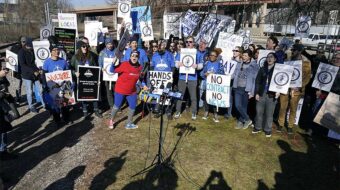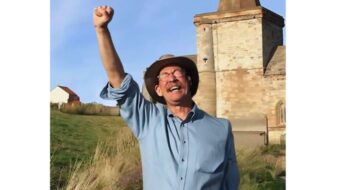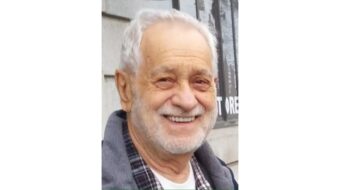In Chicago the month of August is a special time for the residents of the South Side. Every year on the second Saturday of that month the community celebrates its past, its present and its future with a huge outdoor party kicked off by the Bud Billiken parade.
The parade was first held over 70 years ago, and was conceived as a circulation promotion for a Black newspaper, the Chicago Bee. Bud Billiken is not a real person but a name given to the parade in honor of a mythical patron saint of “the little guy.”
This year as we celebrate a mythical hero we have the opportunity to honor an honest-to-goodness living champion of “the little guy” – a man who has been a resident of the community for the past 35 years and spent his entire adult life fighting for the rights and concerns of ordinary working people.
Ishmael Flory has been a member of the Communist Party USA since the early 1930s. His life has been a series of unending struggles and accomplishments. Since the mid-1960s Ish, as most know and call him, and his wife Cathern have resided in Chicago on Drexel Boulevard.
Ishmael Flory was born on the Fourth of July 1907 in Lake Charles, La., the youngest of seven children. His parents both worked to support the family. His mother picked cotton and his father worked in construction.
In 1918 the Flory family moved to Los Angeles to escape the hardships of living in Louisiana following the massive destruction of a 1917 hurricane. As a high school student Ish became aware of the racism around him. At that point he only observed incidents and tried to analyze them. Later, in 1927, as a freshman at University of California at Los Angeles (UCLA), he decided to act.
From his observations of the many organizations and demonstrations taking place on campus he gravitated to those that held a communist point of view. A natural enough tendency considering that, in his early years, he was influenced by his father’s positive views of socialism. His father talked often of the Soviet Union and Lenin, or, as his father pronounced it, “Leneen.”
Ish was comfortable with this way of thinking. He believed that the qualitative changes in the system being called for by the communists would lead to more real progress than the limited reforms that the broad movements were seeking.
In 1949, Paul Robeson, the scholar, singer, actor, athlete and political activist of the world, put it this way:
“Personal success can be no answer. It can no longer be a question of an Anderson, a Carver, a Robinson, or a Robeson. It must be a question of the well-being and opportunities not of a few but for all of this great Negro People of which I am a part.”
Ish agreed. His decision to begin to take an active part in the movement was the beginning of a political odyssey that has lasted 75 years and still counting.
Ish met W.E.B. DuBois, the great scholar, a founder of the NAACP, and, later, a member of the Communist Party, for the first time in 1928. It was a very brief encounter. Dr. DuBois was attending an NAACP conference in Los Angeles. Ish was there with a fraternity brother who was trying to start up a newspaper.
“We were standing on the sidewalk handing out newspapers,” Ish remembers. “Then we see Dr. Du walking down Central with his stick. So we stopped him, and my friend gave him the paper. Dr. Du said, ‘You giving this to me now?’ Then he kept walking to the convention. I didn’t see him again for about 30 years after that.” Ish always referred to him as “Dr. Du.”
The need for money led Ish to leave UCLA in 1929 before getting his degree. He worked for a couple of years as a realtor in Los Angeles, but left that job in 1931 for a higher paying job as a Pullman porter and later as a dining car worker.
The change of lifestyle from student to worker did not change Ish as an observer and challenger of injustice. He became intensely involved in labor struggles against the poor working conditions of the railroad workers. This work culminated with his becoming the executive secretary of the railroad workers’ union.
He and others formed a council representing dining car workers from all over the country. They eventually became affiliated with the International Restaurant and Hotel Employees Union. Ish could now add “trade union leader” to his ever-growing list of accomplishments in the interests of “the little guy.”
During this period he went back to college at the University of California at Berkeley, where he received his degree in 1933. Soon after he was offered and accepted a graduate fellowship in the masters program in sociology at Fisk University.
While at Fisk, Ish became involved in a protest that ended his academic career. This excerpt from a 1934 essay by Langston Hughes, “Cowards from the Colleges,” explains:
“I see in our papers where Fisk University, that great center of Negro Education and of Jubilee fame, has expelled Ishmael Flory, a graduate student from California on a special honor scholarship, because he dared organize a protest against the University singers appearing in a Nashville Jim Crow theater where colored people must go up a back alley to sit in the gallery. Probably also the University resented his organizing, through the Denmark Vesey Forum, a silent protest parade denouncing the lynching of Cordie Cheek, who was abducted almost at the very gates of the University.”
These actions were among the first of their kind in the South. It wasn’t until 25 years later that the sit-ins of the early ’60s, which stunned the world, took place.
Langston Hughes was not the only leading figure in the movement at that time to notice Ish. Dr. DuBois, then the editor of the NAACP’s publication, The Crisis, wrote there about the Fisk incident and cited Flory’s role. He wrote to Dr. DuBois thanking him, to which Dr. DuBois responded, “Go on and continue to write that stuff and get it out there.”
And “get it out there” he did. He continued to write and organize protests until the Fisk faculty, the “cowards” of Hughes’ essay, voted to bring charges against Ish and other organizers and asked them to withdraw from the school. Ish withdrew and never would finish his master’s degree. Undeterred, he kept moving forward. There were, as his continued struggle would prove, bigger fish to fry.
While attending Fisk University, Ish became a member of the Alpha Phi Alpha fraternity, the same fraternity Paul Robeson belonged to when he attended Fisk. Ish’s first meeting with Robeson happened because of this connection and because of a mutual friend, William Patterson, a distinguished attorney and member of the Communist Party who fought for the civil rights of all peoples on many fronts, including the famous struggle to free the Scottsboro Boys.
In 1941 Ish attended a reception for Robeson after a theatrical performance in Chicago. When introduced, Robeson immediately recognized Ish as the person Patterson had talked of. It was the beginning of a long and close personal and political relationship.
This relationship led to Ish’s participation in one of this country’s highlights in the struggle for African American equality.
Paul Robeson had always been active in the struggle to integrate Major League baseball. In 1943, Peter V. Cacchione, Brooklyn’s Communist councilman, introduced a resolution in the New York City Council to desegregate baseball. The pressure of this publicity forced Kenesaw M. Landis, the commissioner of baseball, to agree to let Robeson and eight Black newspapermen attend the annual meeting of the ball club owners in December.
Martin Duberman described the day of the meeting in his book, Paul Robeson: “Mr. Robeson took along to the meeting two friends, William Patterson [founder of the Abraham Lincoln School of Social Research] and the Chicago-based Ishmael Flory [who was executive secretary of the left-wing Negro People’s Assembly and managing editor of its newspaper, The NewWorld] but both were kept cooling their heels in the anteroom.
“Robeson, however, was allowed to address the club owners. ‘I come here as an American and former athlete,’ he told them. ‘I come because I feel this problem deeply.’ For twenty minutes he used his own history to make an impassioned appeal, citing his earlier experience in college football and his current performance as Othello as arguments against the assumption that racial disturbance automatically follows desegregation. When Robeson finished, the owners applauded him vigorously but did not ask questions …”
And as Ish described it: “They wouldn’t let us into the hall. Just Paul. Paul made a hellified speech. And Landis reiterated Paul’s speech by saying, ‘Gentlemen, there ain’t no goddamn reason for you not to have Blacks in this baseball league.”
Two years later, in 1945, Jackie Robinson became the first Black player accepted into Major League baseball.
In the 1940s, Flory serving as an organizer of the International Union of Mine Mill and Smelter Workers. He was sent to Baltimore to direct an organizing drive at the American Smelting and Refining Company, a vital plant producing copper for the war effort. The plant employed 1,500 workers, 60 percent of them African Americans.
Shortly after this era of struggle and progress, the progressive movement in our country was forced into a retreat by reactionary forces bent on destroying any feelings of trust and solidarity toward the Soviet Union. The Soviet Union had been our ally during World War II, the war against fascism, but the war was over. The ultra-right of that period felt it was time to dispel any positive notions the American people might have about socialism. This frenzied trashing of the constitutional rights of the American people culminated with what is today called McCarthyism.
In 1953 Dr. DuBois ran afoul of the notorious House Un-American Activities Committee (HUAC) because of his outspoken advocacy of peace and social justice. “I remember those bastards arresting Dr. Du at 85 years old,” Ish remembers, “and putting handcuffs on him. Eighty-five years old!”
Ten years later, in 1963, when Ish was flying home from a conference in the Soviet Union his plane made a stop in Ghana. He used the opportunity to visit with Dr. DuBois, who had recently renounced his U.S. citizenship, formally applied for membership in the Communist Party USA, and was now living in Ghana as a citizen. Just a few days after Ish’s arrival back in the U.S., Dr. DuBois died.
In 1970, at the age of 63, Ish again picked up his sword and shield and went off to do battle. This time he traveled to Belgium to organize a worldwide campaign to free Angela Davis. She had been arrested and charged in California with being an accessory in a prison escape that ended with people being killed.
Her real “crime” was belonging to the Communist Party and teaching at the University of California while Ronald Reagan was governor.
The efforts of Ish and others were rewarded when Davis was found innocent by a jury who, after announcing their finding of innocence, felt compelled to accuse the State of California of trying to frame an innocent citizen.
Building on the positive outcome of the case and positive public outcry, the Party decided to run Communist candidates in the 1972 elections. Gus Hall, general secretary of the Party, and Jarvis Tyner were the Communist Party candidates for President and Vice President, respectively, and Ish was the Communist Party candidate for Illinois governor. He was also a candidate for the U.S. Senate in 1974 and again in 1984. Having the Party’s name on the official ballots went a long way in legitimizing the right of the Communist Party to exist, a setback for McCarthyism and Ronald Reagan.
In Ishmael Flory’s life thus far, a lifetime of great achievements, it would be difficult if not impossible to point to any single one that will be his legacy. But one piece of his work continues to play a very important role in the people’s movement today.
Throughout his life Ish had a special concern for Black history and culture. So in the mid-fifties he organized the African American Heritage Association, with the support of his wife Cathern and Christine Johnson. Johnson had been a student at Lincoln University with Kwame Nkrumah, and also had an intense interest in her African background.
This small group represented the first organized attempt in Chicago to focus attention on the African heritage of Black Americans.
The African American Heritage Association also gave a new dimension to the study of this subject. It focused on an African American person’s background, not only to promote pride, but also to draw lessons on how to work here to end racial oppression. Classes and forums were organized at the association’s headquarters on 43rd Street near the elevated lines. Many of the people who became active in the civil rights struggles of the ’60s, and continue to struggle today, passed through this school.
These are some highlights of Ishmael Flory’s life “thus far.” It is clear to all who know Ish in life, or by way of this article, that he’s not finished yet.
The authors can be reached at pww@pww.org












Comments